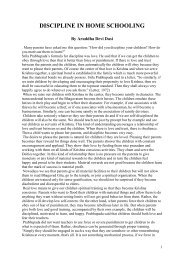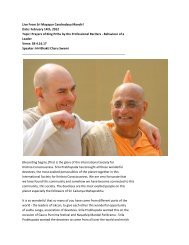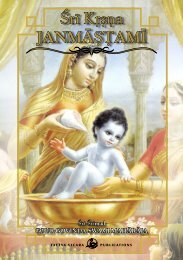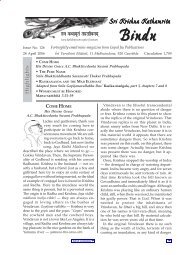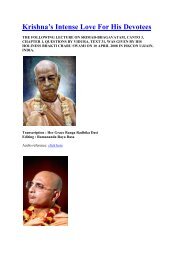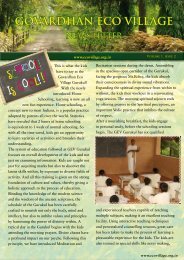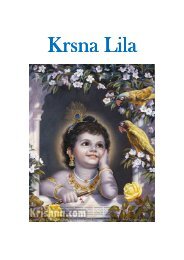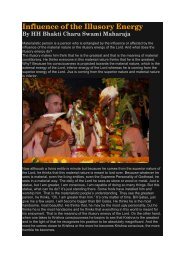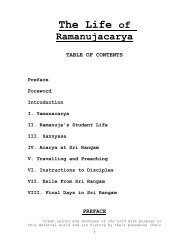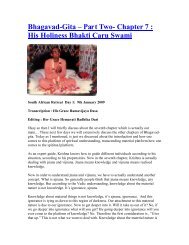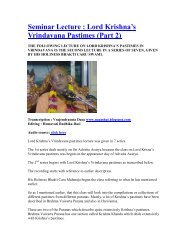CFC January 2012 Newsletter - Care for Cows
CFC January 2012 Newsletter - Care for Cows
CFC January 2012 Newsletter - Care for Cows
Create successful ePaper yourself
Turn your PDF publications into a flip-book with our unique Google optimized e-Paper software.
Jan. <strong>2012</strong><br />
<strong>Care</strong> <strong>for</strong> <strong>Cows</strong><br />
i n v r i n d a v a n<br />
The Sanctity<br />
of the Cow<br />
Four new<br />
Residents<br />
<strong>Cows</strong> in Heat
Jaya Sri Guru! Jaya Sri Gopala!<br />
Jaya Sri Go Mata!<br />
Dear Friends,<br />
<strong>Care</strong> <strong>for</strong> <strong>Cows</strong> in Vrindavana<br />
is inspired by His Divine Grace<br />
A.C. Bhaktivedanta Swami Prabhupada<br />
Founder-Acharya<br />
International Society <strong>for</strong> Krishna Consciousness<br />
<strong>CFC</strong> Trustees<br />
Kurma Rupa dasa<br />
Hansarupa Dasa<br />
Vraja Mohan dasa<br />
Harivallabha dasa<br />
Radha Govinda Dasa<br />
Amit Duhlani<br />
Patrons<br />
Mahanidhi Swami Maharaja<br />
<strong>CFC</strong> Staff<br />
Kesi Nisudana Dasa<br />
Braja Gopal dasa (Switz.)<br />
Puri Maharaja<br />
Rasamandala Dasi<br />
Radhapati Dasa<br />
Syam Hari, Vijay,<br />
Ravi, Sukumar, Santosh, Tej<br />
Prakash, Ajeet<br />
Editor<br />
Kurma Rupa dasa<br />
Contributing editor,<br />
Rasamandala Dasi<br />
<strong>Care</strong> <strong>for</strong> <strong>Cows</strong><br />
i n v r i n d a v a n a<br />
care<strong>for</strong>cows.org<br />
Five calls come from<br />
concerned Vrindavan cowlovers<br />
regarding a handsome<br />
adolescent black bull hobbling<br />
around MVT. His left front<br />
ankle is injured and he can<br />
barely walk.<br />
“He’s going to starve if we<br />
don’t help him.” they all say.<br />
Our recuperation rooms are<br />
full and the unexpected rain<br />
on the first day of the year has<br />
created further crowding.<br />
Rainwater has made the<br />
road under construction to<br />
<strong>Care</strong> <strong>for</strong> <strong>Cows</strong> a slippery<br />
dangerous mess. What to do?<br />
Bhima Karma will supply the<br />
food; Karuna Purna will feed<br />
him and keep him dry; Parvati<br />
will host the unexpected<br />
guest (the personification of<br />
Dharma) in her garden until<br />
Indra’s wrath passes and we<br />
can accommodate him; and<br />
Gopal Bhatta volunteers to<br />
sponsor the black beauty <strong>for</strong> a<br />
year!<br />
Go seva is contagious.<br />
It unites people.<br />
It allows us to practice<br />
compassion.<br />
I hope this issue finds you<br />
experiencing the happiness<br />
and internal satisfaction that<br />
acompanies Go seva.<br />
The <strong>CFC</strong> Staff<br />
<strong>Care</strong> <strong>for</strong> <strong>Cows</strong> in Vrindavan is a Charitable Trust<br />
registered in India, USA, and Switzerland.
~ p o r t r a i t o f t h e m o n t h ~<br />
~ K r i s h n a ~
Visit to Bansi<br />
Gir Goshalla<br />
by Basu Ghosh Das<br />
In early December I<br />
accompanied Jasomatinandan<br />
Prabhu, Acharya Dharmendra<br />
and Acharya Samskritananda<br />
Hari on a visit to the Bansi Gir<br />
Goshalla, on the outskirts of<br />
Ahmedabad.<br />
The goshalla is the private<br />
endeavor of Sri Gopal Sutariya<br />
(Patel), who is a rich “builder”<br />
of Ahmedabad.<br />
He’s a young entreprenuer<br />
- 36 years old - who spends<br />
four hours a day at the<br />
goshalla, looking after the<br />
107 Gir cows. Girs are one of<br />
India’s indigenous breeds of<br />
cattle known <strong>for</strong> being a good<br />
milkers. They are indigenous<br />
to the Saurashtra region of the<br />
present Gujarat state.<br />
Here are some of the<br />
interesting features of the<br />
goshalla gathered during<br />
our visit there.<br />
1. <strong>Cows</strong> and bulls are<br />
“pedigree”. Records of their<br />
lineage have been<br />
meticulously kept.<br />
2. Records of the milk<br />
production of the present<br />
animals are kept, and records<br />
of the milk production of their<br />
ancestors are “in hand”.<br />
3. All cattle are fed fresh,<br />
green grass (no dry grass).<br />
4. Green grass grown at the<br />
goshalla is a special variety that<br />
grows upto 14 feet in height.<br />
5. Only organic cattle feed is<br />
fed to the animals, in addition<br />
to the grass mentioned herein<br />
above.<br />
6. Milk is being sold at Rs.<br />
70 per liter by the goshalla<br />
(the local market rate is Rs.<br />
25/30 per liter). Ghee is also<br />
produced. I neglected to ask<br />
about the retail rate he asks<br />
<strong>for</strong> that.<br />
7. The goshalla has protected<br />
some cows and bulls that<br />
were slated <strong>for</strong> export to<br />
Brazil (where there is a sizeble<br />
population of Gir cattle that<br />
were exported there from<br />
Gujarat in the past.<br />
8. Sri Gopal Sutariya<br />
promised to donate us a oneyear-old<br />
bull, who would<br />
become a breeding bull <strong>for</strong><br />
our exlcusively Gir goshalla at<br />
ISKCON Baroda.<br />
Pictures of the visit can<br />
be seen on the internet at:<br />
https://picasaweb.google.<br />
om/103360994652182030572/<br />
BansiGirGoshallaAhmedabad or,<br />
http://tinyurl.com/6ot83td
Bhola’s daily walks<br />
by Rasamandala Dasi<br />
“Every day Kurma Rupa Prabhu<br />
has been taking an hour out of his<br />
schedule to take Bhola the strong<br />
three-year-old pure-bred Tarparka<br />
bull <strong>for</strong> a daily walk along the road<br />
outside of <strong>CFC</strong> Kiki Nagla. Here<br />
are some beautiful photos which<br />
show how even a powerful animal<br />
like Bhola can be conquered with<br />
love and kindness.<br />
Grazing land has all but<br />
disappeared here in Vrindavan<br />
as in many parts of India<br />
due to urbanisation and also<br />
due to industrial farming<br />
practices with many of those<br />
farmers who have not sold<br />
out to developers having<br />
been persuaded to trade in<br />
their bullocks <strong>for</strong> tractors and<br />
artificial fertilizer to create cash<br />
crops.
In Vrindavan developers have<br />
been investing in huge areas of<br />
land to create so-called green<br />
apartment complexes <strong>for</strong> both<br />
the Delhi residents as a spiritual<br />
weekend Get-Away and also to<br />
house the numerous International<br />
guests.<br />
Although many thoughtful<br />
and caring persons have taken<br />
in many of the cows who had<br />
recovered from their traumas<br />
after being cared <strong>for</strong> at <strong>CFC</strong> (as<br />
reported in previous issues of <strong>CFC</strong><br />
<strong>Newsletter</strong>s) more land is required<br />
to allow the current residents and<br />
newcomers a place to kick up their<br />
heels and play rather than being<br />
restricted to the limited Goshala<br />
area.
New Residents<br />
Rasa is a sevenmonth-old<br />
female calf<br />
who was abandoned<br />
in Madhuvan Colony.<br />
She is very friendly and<br />
determined to get what<br />
she wants. She is a<br />
picture of good health<br />
since she is endowed<br />
with enough aggression<br />
to get her needs met.<br />
She is a natural leader<br />
and enjoys being<br />
groomed regularly. She<br />
requires a sponsor.
This three-year-old<br />
bull got in a fight with<br />
a larger street bull and<br />
was pushed into a drain<br />
under construction. His<br />
left rear leg is swollen<br />
at the joint and he<br />
received minor gashes<br />
all over his legs and<br />
torso. He hobbled to<br />
my door in Madhuvana<br />
Colony as if he knew<br />
that was the place to<br />
get medical aid. He is<br />
presently recuperating<br />
in the winter sun at Kiki<br />
Nagla.
This five-monthold<br />
black bull calf<br />
was found sitting<br />
on the side of the<br />
road in Sundrakh<br />
village. His pelvis<br />
has been injured<br />
and he is not able to<br />
get up by himself.<br />
If he is assisted, he<br />
can stand and walk<br />
around. He has a<br />
good appetite and<br />
we are hopeful he<br />
will recover. fully
New Residents<br />
The above eight-month-old bull calf was<br />
rescued from Sant Colony by two ladies who<br />
called us <strong>for</strong> help. He is healthy, friendly and<br />
well-adjusted. It is apparent that he has not<br />
been on the street <strong>for</strong> long.
<strong>Cows</strong> have Best Friends<br />
by Hannah Velton<br />
News that cows have best<br />
friends comes as no surprise to<br />
those of us who have worked with<br />
them – and their mood swings.<br />
Who would think that beneath<br />
that calm exterior there is a<br />
boiling mass of emotions? I’m<br />
not talking about Wimbledon<br />
champions here, but cows. Yes,<br />
cows; those creatures that we<br />
take milk from, but rarely think<br />
about. According to new research<br />
by scientists at Northampton<br />
University, cows have “best<br />
friends” and get stressed when<br />
separated.<br />
In his book The Cow, the <strong>for</strong>mer<br />
butcher and poet Beat Sterchi<br />
invented an adjective to describe<br />
the way that cows stand placidly<br />
– “cowpeaceably”. If you watch<br />
cows lying down in a field they will<br />
normally be ruminating (chewing<br />
on regurgitated grass), staring<br />
blankly into space and looking<br />
totally at peace. This state of total<br />
calmness makes the cow appear<br />
withdrawn and “otherworldly”. This<br />
is perhaps why we assume there is<br />
nothing much going on between a<br />
cow’s ears.<br />
But we cow lovers have always<br />
known that cows have emotional<br />
depth. DH Lawrence wrote<br />
brilliantly about his relationship<br />
with Susan, a black cow that he<br />
milked every morning in 1924-5<br />
on his ranch in Taos, New Mexico.<br />
He comments on her “cowy<br />
oblivion”, her “cow inertia”, her<br />
“cowy passivity” and her “cowy<br />
peace” and he wonders where<br />
she goes to in her trances. But he<br />
believes, quite rightly, that there
is always “a certain untouched<br />
chaos in her”, which is never far<br />
away. Some days, he writes, she<br />
is “fractious, tiresome, and a<br />
faggot”. This is because she will<br />
deliberately do things to annoy<br />
him, such as swinging her tail<br />
in his face during milking: “So<br />
sometimes she swings it, just<br />
on purpose: and looks at me out<br />
of the black corner of her great,<br />
pure-black eye, when I yell at her.”<br />
To anyone who works, or has<br />
worked, with cows, it comes as<br />
no surprise that cows are capable<br />
of friendships. Within any herd<br />
there is a pecking order that<br />
results in cows coming into the<br />
milking parlour every time in more<br />
or less the same position in the<br />
queue. Certain cows will always<br />
be the ring leaders when trouble<br />
occurs – bulldozing fences until<br />
they give way is often found out<br />
by accident, but then pursued with<br />
great joy by the felons. And woe<br />
be to anyone who gets in the way<br />
of a mother and her calf.<br />
But there are also the gentler<br />
cows who always appreciate a<br />
scratch behind the ear as you go<br />
past and the cows that Temple<br />
Grandin, the animal scientist,<br />
would describe as “curiously<br />
afraid”. These cows, and most<br />
do exhibit this behaviour, will<br />
be curious of any new thing but<br />
terrified of it at the same time.<br />
The braver ones will come <strong>for</strong>ward<br />
to investigate first, but will stand<br />
at such a distance that their necks<br />
and tongues will be stretched out<br />
as far as possible. They will snort,<br />
sniff and try to lick the novelty<br />
until they decide after about 15<br />
minutes that they are bored and<br />
will wander off. There’s a lot going<br />
on between those hairy ears.
<strong>Cows</strong> on Heat<br />
Excerpt from A Manual <strong>for</strong> Primary Animal Health <strong>Care</strong> Worker<br />
Signs of heat (oestrus) in<br />
ruminants<br />
Heat or oestrus is the period<br />
when the female will accept the<br />
male and mate.<br />
There are signs which mark<br />
oestrus in all ruminants.<br />
Recognising when the female is on<br />
heat means you will know when<br />
to put her with the male or use<br />
artificial insemination.<br />
What is heat?<br />
The female reproductive system<br />
consists of two ovaries and a<br />
womb. Every so often the ovaries<br />
produce very small eggs (ova).<br />
The time when this happens is<br />
called heat or oestrus.<br />
Cattle and buffalo regularly<br />
come into heat all year round.<br />
Knowing when a cow is in<br />
heat<br />
If you know when a cow is in<br />
heat you can introduce her to a<br />
chosen male <strong>for</strong> mating or you can<br />
arrange <strong>for</strong> her to be artificially<br />
inseminated if the service is<br />
available. You will also be able to<br />
identify animals which do not go<br />
in heat.<br />
The time to look <strong>for</strong> signs that<br />
the female is in heat is early<br />
morning or evening. Take care<br />
not to disturb the animals but just<br />
watch the animals <strong>for</strong> the signs.<br />
Signs of heat<br />
Ruminants can be kept on<br />
pasture or they may be stabled or<br />
tied up <strong>for</strong> most of the time. It is<br />
there<strong>for</strong>e necessary to consider<br />
this when looking <strong>for</strong> signs of<br />
heat:<br />
1. Signs of heat in free animals<br />
(at pasture):<br />
· Most females in heat will allow<br />
other animals to mount them.<br />
· <strong>Cows</strong> in heat will mount one<br />
another, from the rear or from the<br />
front. However the cow on top<br />
may not be on heat.<br />
· The vulva becomes swollen<br />
and the area around the tail<br />
becomes wet and dirty.<br />
· If cows sniff each others’ vulva<br />
and urine they may both come<br />
into heat.<br />
· <strong>Cows</strong> can be coming into heat<br />
if they stand resting the chin on<br />
the back of another or are seen to<br />
lick or gently butt each other.<br />
· Restlessness and calling<br />
loudly can also mean the female<br />
is coming into heat. Goats in<br />
particular become very noisy.<br />
2. Signs of heat in the stabled<br />
or tied animal:<br />
The animals should be allowed<br />
out twice a day when they can be<br />
watched <strong>for</strong> signs of heat. If the<br />
female is not allowed out then the<br />
following will show that she is in<br />
heat:<br />
· Swollen vulva.
· The animal is active, there is a<br />
loss of appetite and she calls loudly.<br />
· In milking animals the amount<br />
of milk produced suddenly drops.<br />
· A jelly-like mucous can be<br />
found on the floor with the dung.<br />
You will need to be able to<br />
recognise the differences between<br />
signs of heat and signs of ill health<br />
in the animal which is tied up.<br />
How long does heat last?<br />
The duration of heat is short.<br />
· In cows and buffalo it lasts <strong>for</strong><br />
less than a day.<br />
·A healthy animal which was<br />
not mounted by a male or given<br />
artificial insemination will come<br />
back into heat. Cattle and buffalo<br />
cows will come into heat after 3<br />
weeks (give or take a day or two).<br />
The female which does not<br />
come into heat<br />
The female may not show signs<br />
of heat because she is too old, or<br />
she may have been mated without<br />
the owner knowing. Sometimes<br />
animals come into heat without<br />
showing any signs. This is called<br />
a “silent heat” and is common in<br />
buffalo cows. If the feed is not<br />
sufficient or there is a lack of<br />
protein, salts or water, the animal<br />
can fail to come into heat. You will<br />
need to improve the female’s feed<br />
to bring it into heat.<br />
If young, well fed females do<br />
not come into heat or do not<br />
become pregnant you should ask<br />
your local veterinarian <strong>for</strong> advice.
Thank You<br />
From the <strong>Cows</strong><br />
The cows send their heart-felt thanks to those who assisted during December 2011<br />
A. Gerdziuniene<br />
Aditi Sathye<br />
Adjitananda Das<br />
Alina Yershova<br />
Amit Goswami<br />
Andrey Krivokoritov<br />
Anil Kumar<br />
Anna Palijcuka<br />
Anonymous<br />
Anuradha Kovelamudi<br />
Ariel Tel<strong>for</strong>d<br />
Artem Polygalin<br />
Asvin Gupta<br />
Avinash Beeravolu<br />
Bernard Faustino<br />
Carl & Stella Herzig<br />
Carol Simpson<br />
Chandricka Pasupati<br />
Christian Kastner<br />
Danielle Metin<br />
Danil Kolobaev<br />
Derek Carroll<br />
Devaki Kumar dasa<br />
Devender Kumar<br />
Dina Sarana Dasa<br />
Doyal Govinda Dasa<br />
Elena Emelenko<br />
Elena Niki<strong>for</strong>ov<br />
Gaurangapriya Dasi<br />
Hamlesh Motah<br />
Hooman<br />
Jai Simman<br />
Janaki Romano<br />
Jayasacisuta dasa<br />
Johan Wallander<br />
Joseph Frankl<br />
Kamala Melzack<br />
Kantilal Shivlal<br />
Kitri Waterman<br />
Krpa Sindhu & Kuching devotees<br />
Krush Deepak<br />
Liliya Toneva<br />
Loredana Koraca<br />
Madhavi Guntupalli<br />
Mandira Mani & Sri Govinda<br />
Marina Gritsay<br />
Marja Langkamp<br />
Mark Leigh<br />
Mary L Valerio<br />
Mayapurchandra & Champaklata<br />
Mika Tuominen<br />
Miniketanarama Dasa<br />
Nalini Gogar<br />
Nayan Ruparelia<br />
Nealesh Narayan<br />
Panthea Macknight<br />
Paolo Musu<br />
Pure Heart<br />
Rachel Borsch<br />
Rahul Sharma<br />
Ramesta Dasa<br />
Rasamandala Dasi<br />
Ravi Gopal<br />
Robert Gud<br />
Rohini Suta Dasa<br />
Sanjiv Keswani<br />
Sraddha Rajkomar<br />
Srinivasan Ganesan<br />
Subha Anand<br />
Svetlana Sanatina<br />
Tracy Molina<br />
Venkata Venkateswaran<br />
Venkatesh Raghavan<br />
Vijay Sharma<br />
Vikas Shah<br />
Viveck Baluja<br />
Vyasapada Dasa<br />
Yajnavalkya Dasa<br />
May cows stay in front of me; may cows stay behind me; may cows stay on both<br />
sides of me. May I always reside in the midst of cows. —Hari Bhakti Vilas 16.252




